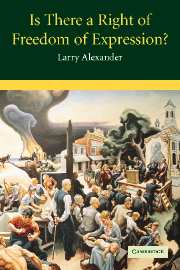Book contents
- Frontmatter
- Contents
- Acknowledgments
- Introduction
- PART ONE DEFINING HUMAN RIGHTS AND DELIMITING THE SCOPE OF FREEDOM OF EXPRESSION
- PART TWO THE CORE OF FREEDOM OF EXPRESSION: GOVERNMENT REGULATIONS AND ACTS TAKEN TO AFFECT MESSAGES
- PART THREE THEORETICAL PERSPECTIVES ON FREEDOM OF EXPRESSION
- EPILOGUE
- Index
Introduction
Published online by Cambridge University Press: 07 January 2010
- Frontmatter
- Contents
- Acknowledgments
- Introduction
- PART ONE DEFINING HUMAN RIGHTS AND DELIMITING THE SCOPE OF FREEDOM OF EXPRESSION
- PART TWO THE CORE OF FREEDOM OF EXPRESSION: GOVERNMENT REGULATIONS AND ACTS TAKEN TO AFFECT MESSAGES
- PART THREE THEORETICAL PERSPECTIVES ON FREEDOM OF EXPRESSION
- EPILOGUE
- Index
Summary
The title of this book asks a question. The aim of the book is to answer it.
Part One, the first three chapters, lays the foundation for the inquiry. Chapter One takes up two questions: What kind of thing is a “human right” and what kinds of activities come within the scope of freedom of expression? It provides an answer to the first question, and it eliminates some possible answers to the second.
Chapter Two focuses entirely on the second question. Its task is to exclude from freedom of expression all laws that incidentally affect what gets said, by whom, to whom, and with what effect – that is, laws that have “message effects” but that are not enacted because of their message effects, so-called Track Two laws. I conclude that the scope of freedom of expression is confined to laws passed with the purpose of affecting messages.
In Chapter Three, I digress somewhat to point out some curious consequences that follow from a jurisprudence focused on government's purposes in enacting laws rather than on those laws' effects. In particular, a focus on purpose may invalidate laws whose message effects are more benign than those of laws not enacted for their message effects and thus untouched by a right of freedom of expression.
Part Two is primarily concerned with laws enacted for the purpose of affecting messages.
- Type
- Chapter
- Information
- Is There a Right of Freedom of Expression? , pp. xi - xiiPublisher: Cambridge University PressPrint publication year: 2005

